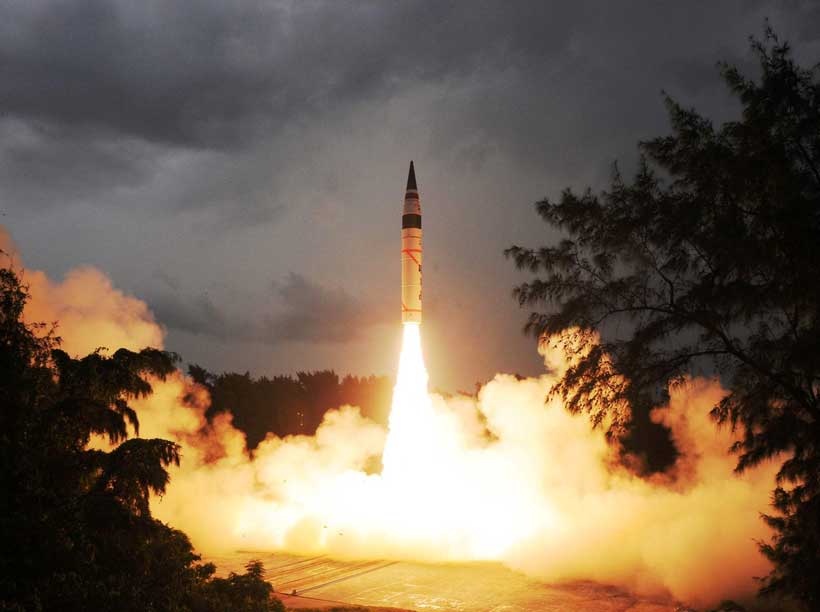 Three main nuclear players of Asia: China, India and Pakistan have established “triangular” dilemma due to their security concerns. This is manifested through the development of advanced conventional and nuclear weapon forces. China is pursuing military modernization program to counter US in Asia-Pacific region, whereas India’s development of sophisticated strategic forces is aimed towards China and Pakistan. India’s acquisition and development of such deterrent of conventional and nuclear forces is a matter of concern for Pakistan and Chinese security planners. In response, it is inevitable for Pakistan to take measures for its security and safety.
Three main nuclear players of Asia: China, India and Pakistan have established “triangular” dilemma due to their security concerns. This is manifested through the development of advanced conventional and nuclear weapon forces. China is pursuing military modernization program to counter US in Asia-Pacific region, whereas India’s development of sophisticated strategic forces is aimed towards China and Pakistan. India’s acquisition and development of such deterrent of conventional and nuclear forces is a matter of concern for Pakistan and Chinese security planners. In response, it is inevitable for Pakistan to take measures for its security and safety.
Such dynamics has established multifaceted security trilemma between three Asian nuclear weapon states due to which induction and introduction of any technology in conventional and strategic forces of one state is matter of security concern for other state. This is expressed through the India’s offensive policies and strategies in pursuit of global power projection, and such dynamics has ability to disturb the deterrence equilibrium and strategic stability of the region. In this regard, recent launch test of Agni V demonstrates that India aims to establish credible strategic forces against China, which would not justify its claim of remaining “minimum’ against Pakistan.
Trends in India’s missile testing and acquisition in nuclear technologies demonstrates that India is largely supported in its quest of strategic forces modernization by the states including United States, France, Russia and other European states. In SIPRI report of 2018, India is ranked as largest arms importer of the world and its technological transfer and foreign acquisitions are running in parallel with its motivation to increase the range, payload, reliability and accuracy of missiles, ICBMs, MIRVs, SLBMs and development of space program.
The United States is supporting the India’s military developments for its own strategic, economic, political and military goals in strategic landscape of Asia. Since US is supporting the India as a Great power in South Asia, the India has been attempting to prove its conventional and nuclear credentials. Therefore, such aspirations demand from India to obtain more resilient and disastrous military muscles. Therefore India’s missile inventory especially canister launch of Indian ICBM Agni-V has played key role in soothing the India’s self-image of a regional power and strategic objective of US. Moreover, its operational launch has ability to increase security dilemma in South Asia as well as in the whole region as its range makes its capable to hit neighboring states Pakistan, China, and whole continent of Asia: and also parts of other continents such as Europe and Africa.
On January 18, 2018 first “Pre-induction” successful test of Agni-V was conducted. Agni V is three stages, solid fueled, intercontinental ballistic missile (ICBM). The range of the Agni V is 5,500-5,800 KM, it is capable to carry warhead of 1,500 Kg. Later in June 2018, canister-launch test of Agni V was carried out. The canister-launch version of the missile enables the quick transport of the missile and provides the capability to launch it anywhere. Canister launch of the Agni-V will lower the nuclear threshold in the region and increase the crisis instability. Consequently, according to the report, India is working to incorporate MIRVs technology with Agni V for its credible second-strike capability.
The objective of first three nuclear missiles (Agni-I, Agni II, Agni III) was to counter Pakistan, whereas the other missiles of the series (Agni-IV, Agni-V) are capable to hit the China due to the longer ranges. The successful canister launch test of Agni V demonstrates that the soon nuclear capable missile will be inducted into Indian Strategic nuclear command. The Canister-launch of the Agni-V will reduce the launch time and pairing it with MIRV technology will have destabilizing effect on the deterrence and strategic balance of Asia. The induction and introduction of operation ready Agni-V will have serious repercussions for geostrategic landscape of region.
India’s latest developments and missile proliferation indicates the India’s shift to acquire more offensive capabilities. Presently, India’s focus to increase the range of its missiles and shift from liquid to solid fueled missiles to enhance the level of readiness and tri-service operation of nuclear-tipped missile. These developments are providing pre-emptive capabilities to the India that is inconsistent with the India’s nuclear posture of “Credible Minimum Deterrence”. India’s offensive conventional and missile capabilities deterrence stability negatively influence the security architecture of region. Therefore, canister launch of Agni-V; marked by advance range, accuracy, payload and higher level of readiness has not only increased the security dilemma and instability in the region but it is also threatening its’ neighboring states with its military buildup.
No comments:
Post a Comment